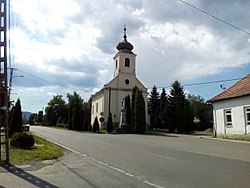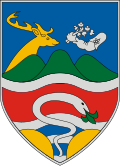Parád
 Parád is a large village in Heves County, Hungary, in the Mátra mountain range, the bottom of the northern side of the Kékes peak, beside of the Parádi-Tarna creek. As of 2022 census, it has a population of 1862 (see Demographics). The village located 6.4 km from (Nr. 84) Kisterenye–Kál-Kápolna railway line, 27.9 km from the main road 3 and 34.5 km from the M3 motorway. Although the Recsk-Parádfürdő railway station is the closest, but public transport on the railway line ceased on 3 March 2007. The closest train station with public transport in Gyöngyös 26,9 km far. The eastern end of the village (Parádfürdő) have an own postal code (3244). HistoryThe settlement was first mentioned in a document in 1506, when it was mentioned as Parad. In the 17th century, the settlement came into the possession of the Rákóczi family. Prince Francis II Rákóczi established a glass huta called Parádóhuta, which he later moved to Parádsasvár. The later owners developed the glass huta into a factory. Queen Maria II ordered an inventory of the country's mineral waters in 1763. Ferenc Markhot, the medical officer of the county, discovered mineral water containing alum, which was already used to treat leg pain, leg tumors and ulcers. The alum factory began operating in 1778. The alum water was mainly used for skin diseases and malignant rashes. As a result of using the water, a new part of the settlement is born: Parádfürdő. The first bath house was built in 1795 by Baron József Orczy, the owner of the estate. András Fáy was the first well-to-do spa guest of the spa, but Lajos Kossuth also tried to restore his shaken health in the baths here. Construction and development continued around the baths, and they became more and more well-known. Noble and aristocratic families traveled to the Parade in the hope of healing, physical and spiritual strengthening. Following the glass factory in Parádsasvár, glassmaking, the production of bath glasses and the bottling of sulfur-hydrocarbonate sour water appeared. Glass art making is still practiced today in Parád, although the glass factory has ceased to exist. A grinding workshop was set up to make crystal glasses in 1803. The church of the village built in 1768 and its frecos made in 1966. Health resortAt Parádfürdő and in its immediate vicinity, there are three different types of water with excellent healing effects. The alum mine is located about 100 meters from the hospital in Parádfürdő, where the mineral is mined and prepared for treatment. The hospital uses the curative alum-iron water for various treatments. Sour water with sulfur bicarbonate is effective in the case of stomach and intestinal diseases, diabetes, pancreatic and bile diseases, chronic constipation, and catarrhal symptoms (respiratory-urinary catarrh). It is used exclusively in the form of a drinking regimen, and can also be partially purchased commercially. At the southeastern end of Parádóhuta, on the edge of the forest, there is the source of iron-lithium-containing sour water (Clarissa, named after Countess Clarisse Kornis), which increases the temperature of the body with its carbonic acid content, accelerates blood circulation, and is important in blood formation due to its iron content. It is used as an oral cure. The Erzsébet Park Hotel built its own mofetta 100 m from the hospital building in 2010. For the treatments, almost pure carbon dioxide, formed during the volcanic after-action and bursting to the surface from a depth of 1000 m, is used. Mofetta can only be used on medical advice. Gas treatment has been shown to have a beneficial effect in six disease groups: hypertension, heart and peripheral vascular diseases, vascular complications in diabetics, conditions after vascular surgery, bone disorders, neuralgia and chronic skin diseases.[4] The walks in the Ilona valley are also recommended, which is famous for its row of chestnut trees, the waterfall and the sulfur bicarbonate spring named after King Saint Stephen. DemographicsAccording the 2022 census, 92.1% of the population were of Hungarian ethnicity, 7.8% were Gypsies, 0.8% were German and 7.6% were did not wish to answer. The religious distribution was as follows: 45.7% Roman Catholic, 4.0% Calvinist, 0.5% Greek Catholic, 14.8% non-denominational, and 32.3% did not wish to answer. The Gypsies have a local nationality government. 1783 inhabitants live in inner areas and 13 people in 3 farms. The other inner area of the village is the outskirt Parádóhuta what is 2.7 km far from the village with 170 people.[5]
Population by years:[7]
PoliticsMayors since 1990:
It is an interesting fact that in the settlement election held on 18 October 1998, the village had 8 mayoral candidates, which is much more than the national average. References
External linksWikimedia Commons has media related to Parád. |
||||||||||||||||||||||||||||||||||||||||||||||||||||||||||||||||||||||||||||||||


















